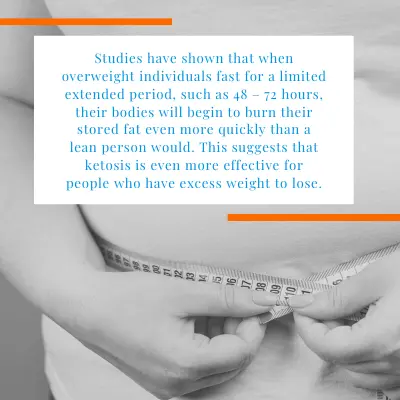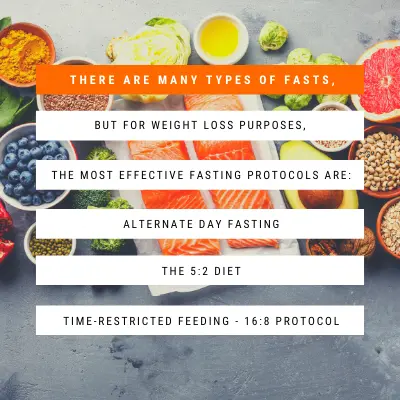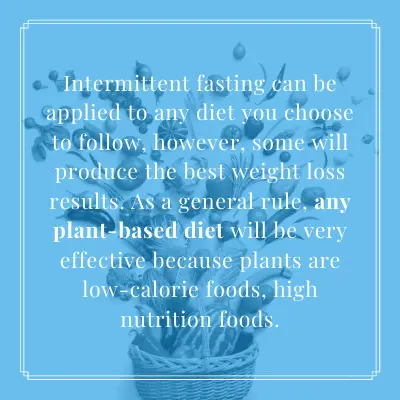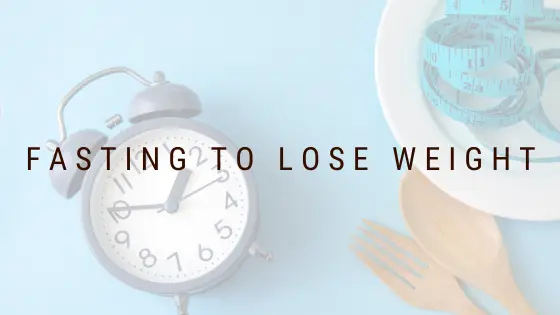If you’ve been struggling with your weight for too long, it may be time to consider fasting to lose weight. Alone, fasting is not generally a weight-loss technique, but when paired with a healthy diet and a moderate amount of physical activity, it can help you bust through weight loss plateaus and maximize your weight loss efforts. Fasting will also support your overall health while you diet, protecting your body from damaging side effects that often go along with weight loss plans. Finally, but incorporating fasting into your weight loss program, you’ll be more likely to create sustainable weight loss that you’ll be able to maintain for the long term.
Is Fasting a Good Way to Lose Weight
Fasting is a great weight to support your weight loss goals, though it shouldn’t be your entire weight loss plan of attack. Fasting helps improve the efficiency of your metabolism, which will make it easier for you to put the food you eat to good use, rather than storing it as fat. It will also help curb cravings and stop hunger signals from firing at all hours of your day, making it easier to stick to your healthy eating plan.
Fasting is not a miracle diet, however, and you should never starve yourself in an effort to lose weight. When used correctly, fasting can help you kickstart a successful weight loss journey or help you overcome a weight loss plateau.
Why Does Fasting Work
Using intermittent fasting to lose weight is most effective as a reset tool. One of the most effective ways to practice this technique is simply to try a 48 hour fast once every few months. Not only will it help you move past any weight loss plateaus you may have settled into, but it also has quite a few other key benefits that will support your overall health, fitness and weight loss goals.
While there are benefits of fasting for a day or even shorter periods, there are some advantages to sticking it out for a full 2 days. The primary reason for this is the surplus of ketones that flood your body when you restrict food for longer periods of time. Fasting and ketosis is a hot topic for another article, but what you should know is that ketones are your body’s natural solution to fuel when energy is not being provided through food.
Studies have shown that when overweight individuals fast for a limited extended period, such as 48 – 72 hours, their bodies will begin to burn their stored fat even more quickly than a lean person would. This suggests that ketosis is even more effective for people who have excess weight to lose.

Water Fasting for Weight Loss
When you hear reference to water fasting it’s usually in relation to slightly longer fasts, usually ranging between 1 – 3 days, but sometimes extending to 7 or even 10 days.
If you decide to fast for any longer than 72 hours, it should be done with supervision and medical approval, especially if you have any pre-existing medical conditions. However, in relatively healthy bodies, the longer the fast, the more efficient your body will become at burning stored energy – aka fat.
Many people who are in the range of obese or morbidly obese and coping with significant health difficulties seek out professional help to guide them through a 7-day water fast for weight loss, but if you only have 10 – 20 pounds to lose, you don’t have to go to such extreme fasts. You can try short-term daily or weekly fasting to see slow, steady and, best of all, sustainable weight loss results over time.
Best Intermittent Fasting for Weight Loss
Intermittent fasting benefits can be seen after as little as 12 hours without food, but for weight loss anything between 12 – 48 hours is ideal. Some studies have shown that fasting for longer than 48 hours can create slight muscle mass loss, and when you’re trying to lose weight, you want to maintain all the muscle possible, as it helps you burn calories more quickly.
There are many types of fasting, even within the designation of intermittent, and I discuss them in great depths in another article. For weight loss purposes, we’re mostly interested in alternate day fasting, or the 5:2 diet or time-restricted feeding (TRF), such as the 16:8 protocol for fasting.
What is alternate day fasting? Just what it sounds like. Every other day you restrict your calories either entirely or at least to a very limited amount, such as 500 – 600 calories. The 5:2 diet is slightly less intense, requiring you to restrict food only 2 days out of every 7. The other days you can eat normally, though if weight loss is your goal you should always be focused on high-quality foods with plenty of vegetables, lean proteins, and healthy fats.
Time-restricted feeding is a type of daily fast in which you limit your food intake to within a certain time period each day, usually 8 – 12 hours. The 16:8 protocol suggests you fast for 16 hours each day and eat healthfully within an 8-hour window.

Intermittent Fasting Pros and Cons
There are many pros to intermittent fasting in terms of weight management. On the surface, it creates a structure for you to exist within to strategically manage the food you’re eating. Planning your meal timing is a simple step toward planning your meals and calorie consumption, and creating a habit around this will make your weight loss plan easier to stick to for the long term.
There is a very interesting body of research that shows alternate day fasting can help improve the quality of your gut microbiome. Not only is this good for your overall health and well-being, boosting your immune system and cleaning your gut of bad bacteria more quickly, but it can also help convert your stored white fat into brown fat. Assuming you’re not a doctor, what this means is that the fat that is simply hanging out in your body, doing nothing but taking up space (white fat) will be put to work managing your body temperature (brown fat). Brown fat is a healthier type of fat that your body burns more readily.
A healthy gut also decreases symptoms of bloating, which makes you feel and look slimmer, even if it doesn’t change the numbers on your scale.
The biggest con for intermittent fasting happens when it’s used as an excuse to indulge in poor habits outside of fasting. Fasting is not a miracle cure and if you continue to eat low-quality food in excess with little to no movement, you will continue to gain weight, regardless of how frequently you fast or how strict you are with your fasting regimen.
Intermittent Fasting Weight Loss Plan
While you’re fasting, you should also be putting into practice a few other techniques to help you lose weight quickly, yet sustainably. Here are a few quick tips to help you design your own weight loss plan:
- Continue to exercise: working out while water fasting can help you burn fat even more effectively, and protect your muscles at the same time
- Drink black coffee and tea: when you’re
fasting it can help to drink black coffee or tea for a few reasons:
- it will keep you occupied and feeling like you’re consuming something, even though it has no calories,
- caffeine can also help encourage your metabolism to burn fat, and
- it will help regulate your body temperature, which can dip during extended fasts
- Manage your minerals: you can either supplement with sodium and potassium or electrolytes to make sure you’re staying optimally hydrated
Prevent Fasting from Backfiring
You may have heard that fasting can actually cause you to gain weight, and this can be true if you’re committing a few common fasting mistakes. Prevent fasting weight gain by following these simple rules:
- Manage insulin sensitivity. After a fast, your cells are going to be hungry and therefore you will be highly insulin sensitive, which allows your cells to take in energy. When you break your fast, you need to be very careful that you don’t eat too much and that you keep your consumption limited to lean proteins and nutrient-dense plants. This will feed your cells healthfully without giving them more fat to hold onto.
- Prevent metabolic slowdown. Make sure that between your fasts you’re eating enough calories to support your metabolism, but not so much that you add fat or imbalance hormones like insulin or leptin. Keep your food high quality and regulated for health, which will support fat burn.
- Protect your muscle. Muscle boosts your metabolism so, even if you’re not trying to build muscle, you want to make sure you protect the muscle you have. As you fast, your body burns everything it can to create protein which is what each and every cell in your body made of. After your fast, the best way you can help your body recover is to give it high-quality protein. When you fast, you may need to eat more protein than you’re used to.
Foods to Eat While Fasting
Intermittent fasting can be applied to any diet you choose to follow since it only governs when and how often you eat, not what you eat. That being said, there are some diets that work very well with fasting to produce the best weight loss results. As a general rule, any plant-based diet will be very effective because eating plants increases the nutrition available to help your body operate effectively and generally, they’re low-calorie foods.
Plant-based diets simply mean that the main focus of your food intake is on plants, such as vegetables, fruits, legumes, nuts, and seeds. This doesn’t mean you can’t eat meat or animal products; they simply play a minor role.

Best Food for Fasting
When you’re trying to determine the best food for fasting in your lifestyles, you need to consider it from three angles: what to eat before you fast, how to break your fast, and what to eat between your fasts.
When you’re entering into a fast, trying to eat as few carbs as possible in your last meal. Carbohydrates stimulate a hormone called leptin, which makes it more difficult for fat burning to take place, which is the opposite of what you want to accomplish with your fast. It will also help protect your muscle mass and target fat specifically for fuel. Focus on high-quality lean proteins and healthy fats, paired with low-carbohydrate vegetables as your last meal.
How you break your fast is just as important as fasting itself. After a fast, your body is extremely sensitive to any calories coming in, so you want to be very strategic about what you offer it. Lean protein is the best food to break your fast with. Plant-based options are excellent because they also provide a lot of vitamins and nutrients that your body can put to use immediately. Having a simple porridge made from whole grains and seeds such as hemp and buckwheat, along with some dark chocolate, berries and some coconut milk is perfect.
The one food you definitely want to avoid when you break your fast is nuts. The phytic acid in nuts or even nut milk will coopt the vitamins and minerals in any other foods you eat, which your body needs after a fast even more than usual.
Now that you know how to begin and end a fast, let’s talk a little bit about what you eat when you’re between fasts.
Fasting and Dieting
If you’re overweight and unhappy with the amount of fat on your body, you may think that a low-fat diet for weight loss is going to be your best bet. This is not usually the case. Fat is a key macronutrient that helps your body and brain function. If you’re not eating any fat, your body will hoard what it has instead of burning it because it’s unnecessary. What you should focus on is the quality of fat in your diet, and making sure you’re not overconsuming fat, because it is high in calories.
On the other end of the spectrum is the Keto diet, which is a high fat, low carb plan that many people find is very efficient at releasing fat and triggering the benefits of fasting.
Somewhere in the middle are plans such as the Mediterranean diet. This is a whole foods-based approach that features plenty of rich nutrition, healthy fats, and lean proteins. It’s known to be very anti-inflammatory, which can improve symptoms of just about any health condition.
If you are following a vegetarian or vegan diet, you will need to make sure you’re getting a variety of plants in your diet and still relying on whole foods and not vegan junk food. Quality protein and fats are easy to come by, even on a vegan diet, but are best found in sources such as nuts, seeds, and legumes.
Overall, if you’re following a diet while you fast, you want to make sure you’re considering the source and quality of your food and not just the calorie count.
Frequently Asked Questions about Fasting for Weight Loss
How long should I do intermittent fasting?
There are many people who fast intermittently their entire lives and are incredibly healthy for it. IF isn’t a diet or a temporary weight loss plan, it is a lifestyle for many people. While you should avoid repeating prolonged fasts frequently, you can live your entire life either restricting your daily feeding window or restricting food for one or two days out of each week. The key to any health or weight management plan is to find a routine that is manageable for you to commit to in the long-term, adapting slightly as your goals change.
How long does it take for 16:8 intermittent fasting to work?
Intermittent fasting will have positive health benefits each and every time you give your body a break from eating. In that sense, it takes only a single day to start “working.” In terms of weight loss, however, the answer gets difficult to qualify. Fasting should only be part of your weight loss plan, so your caloric intake, physical activity and even quality of sleep will impact whether or not restricting your feeding to a 16:8 window will help you reduce your BMI. In some cases, when people follow a reasonable caloric deficit, eating healthy, nutritious foods, getting plenty of water, sleep and also a moderate level exercise, you can see weight loss within 3 days. If fasting is your only method of weight management, it may take up to 3 weeks to see any noticeable physical changes, though you’ll likely start feeling healthier within a few days.
What is the leangains protocol?
Leangains is the brand name of a specific nutritional consultant/personal trainer, Martin Berhan. He went through a rather striking personal transformation with a lot of work and dedication, but credits much of his success to a specific schedule of fasting and training hard. Depending on the person, this protocol will incorporate from 1 – 3 meals per day, but also relies on fasted training in the morning. This protocol is designed to help his clients gain weight, in muscle mass, not lose weight in fat.
Track Your Fasting Weight Loss Success
If you’re new to fasting or trying to learn how best to use fasting to support your weight loss goals, download your free copy of my Intermittent Fasting for Beginners – Printables Pack. You’ll find a printable fasting tracker, to help you plan your meals and stick to your optimal feeding window each day. I’ve also included charts to help you identify your eating habits so that you can tweak anything that may not be working for you, a fitness measurement goal tracker, and a few guided journal prompts to help you put your health goals into words so that you can measure your progress toward success.
Download your free printables now >> Intermittent Fasting for Beginners
Case Studies and Research
- Intermittent Fasting Promotes Bacterial Clearance and Intestinal IgA Production in Salmonella typhimurium‐Infected Mice
- Intermittent Fasting Promotes White Adipose Browning and Decreases Obesity by Shaping the Gut Microbiota
- Flipping the Metabolic Switch: Understanding and Applying Health Benefits of Fasting




